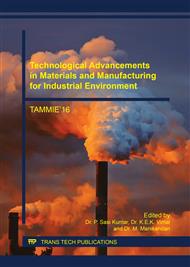p.112
p.119
p.127
p.134
p.148
p.157
p.165
p.171
p.177
Parametric Optimization of CNC End Milling Process on Aluminium 6063 Alloy Using Grey Based Taguchi Method
Abstract:
This investigation focused on the multi-response optimization of CNC end milling of Aluminium 6063 Alloy material using Grey relational analysis and Taguchi method. Experiments were designed based on L9 Taguchi Orthogonal array, to arrive at an optimum parameter combination within the experimental domain. The spindle speed (S), feed rate (f) and depth of cut (d) which are known to have considerable effect on the selected responses i.e. surface roughness (Ra) and Material removal rate (MRR) and are considered as control parameters. The single objective optimization using Taguchi method more often results in conflicting requirements on control variables. To overcome this challenge, the Taguchi approach followed by Grey relational analysis was applied to solve this multi response optimization problem. The significance of these factors on overall quality characteristics of the milling process has also been evaluated quantitatively with the Analysis of variance method (ANOVA). Optimal results were verified through confirmation experiments. This shows feasibility of the Grey relation analysis in combination with Taguchi technique for continuous improvement in product quality in manufacturing industry and the suitability of the method to optimize the multi objective problems involved in CNC milling.
Info:
Periodical:
Pages:
148-156
Citation:
Online since:
July 2017
Authors:
Keywords:
Price:
Сopyright:
© 2017 Trans Tech Publications Ltd. All Rights Reserved
Share:
Citation:


